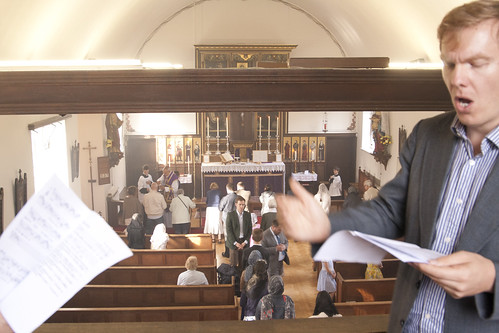 |
| Mass with the Schola at SS Gregory & Augustine, Woodstock Road, Oxford |
This is what the Schola was founded to do, since choirs singing in other liturgical contexts, and outside all liturgical contexts, are abundant in Oxford.
It is also historically and aesthetically appropriate since the music we are singing was composed for the liturgy, and specifically the Catholic liturgy of the 'former liturgical tradition'. While there has been a great deal of liturgical development since some of the most ancient chants were composed, the form in which they come down to us is adapted to the Roman liturgy of the mid 20th Century; the polyphony of the Renaissance is for the most part equally usable in this liturgical context.
The liturgical reforms which followed the Second Vatican Council cause problems for this musical tradition in two ways. First, in fewer places is it possible to sing while the priest silently prays parts of the Mass. This means that if certain chants or pieces of polyphony, such as a Sanctus and Benedictus, are to be sung at all, they will hold up the Mass: in effect the liturgy comes to a halt while the choir sings. This is not what the composers intended, and makes the music, which is supposed to serve the liturgy, disrupt it instead.
Secondly, the spirit and letter of the reformed liturgy places 'accessibility' and 'participation', in the sense of the congregation being able readily to understand the words and take part in the singing, above the creation of a sense of the sacred. The spirit of the Catholic musical tradition does the opposite. The kind of access and participation envisaged is that of a deep interior appreciation of the sacred drama unfolding at the altar. This is assisted by complex, solemn and profoundly moving music, whose words are often familiar to the congregation even if they are in Latin or Greek.
As St Thomas Aquinas expressed it, speaking of the sung Latin liturgy: 'even if some of them understand not what is sung, yet they understand why it is sung, namely, for God's glory: and this is enough to arouse their devotion.' (Summa Theologica IIa IIae Q91 a.2 ad 5)
Although the Second Vatican Council insisted on Gregorian Chant ('The Church acknowledges Gregorian chant as specially suited to the Roman liturgy: therefore, other things being equal, it should be given pride of place in liturgical services.' Sacrosanctum Concilium 116), when the reforms actually took place the loss of this musical patrimony was regretted rather than denied. Paul VI acknowledged openly 'We will lose a great part of that stupendous and incomparable artistic and spiritual thing, the Gregorian chant' (General Audience, 1969). The Congregation for Divine Worship noted that 'Any performance of sacred music which takes place during a celebration, should be fully in harmony with that celebration. This often means that musical compositions which date from a period when the active participation of the faithful was not emphasized as the source of the authentic Christian spirit are no longer to be considered suitable for inclusion within liturgical celebrations.' (Concerts in Churches, 1987).
Happily, the use of the Missal of 1962, with all its ceremonies, rubrics, proper laws, and musical tradition, has now been given full rights within the Catholic Church. Pope Benedict XVI has declared that this Missal was 'never abrogated' (that is, never forbidden), and that it is a treasure for the whole Church which should be fostered (Summorum Pontificum, 2007 and the accompanying Letter to Bishops). The use of the great patrimony of Catholic music, particularly Gregorian Chant and the golden age of Renaissance Polyphony, is certainly fully in harmony with this liturgy, and it is the privilege of the Schola Abelis to contribute in this way to the artistic and liturgical restoration taking place within the Church.

